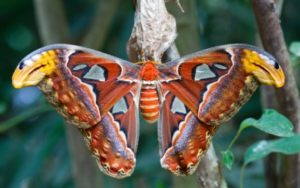
The average house moth is about half an inch long from wing to wing. They’re mottled grey and brown, and a common pest in attics, closets and wardrobes. You’ve likely seen them before and thought nothing of it. But if you were to step outside in Washington and catch sight of a massive, deep-orange insect with a wingspan roughly the size of your hand, you will have been lucky enough to see moths like you’ve never seen them before. They’re called Atlas Moths, native to Southeast Asia, and they’ve recently been spotted in the United States for the first time in recorded history. But what can you expect from these so-called “gentle giants”, and what are the chances they’ll show up in Tennessee?
Atlas Moths: What You Need to Know
How does a moth like the Atlas cross thousands of miles across the globe to the Pacific Northwest? The answer to that is still uncertain, but there have been reports of a party in Bellevue, WA selling Atlas moth cocoons from Thailand for $60 a piece. Regardless of where they came from, they are federally quarantined pests, meaning it’s illegal to obtain, harbor, rear or sell them without a permit. Currently, it’s uncertain whether there is an actual infestation in Washington, and residents are advised to photograph any potential specimens and report them to the state department of agriculture. You can identify an Atlas moth by the following:
- Size: Atlas moths are one of the biggest moth varieties in the world, with a wingspan of up to ten inches.
- Coloring: Their wings are vibrantly hued in shades of brown, orange, white and black.
- Wing tips: Possibly one of the most distinct qualities of the Atlas Moth are the tips of their wings, which evolved to resemble the heads of cobras, as protection against predators.
- Movements: The Atlas Moth will stay in one place for hours at a time during the day. They are so focused on conserving energy that you can easily lift them up on your hand or finger during.
With all that in mind, if you see one of these legendary exotic insects you may still ask – are Atlas moths bad for Washington? And is there a risk of seeing an Atlas moth in Tennessee?
Possible Dangers of the Atlas Moth
If you see an adult Atlas moth, it wouldn’t cause much trouble other than the possible initial shock. They don’t sting or bite, they have no poison or any defense mechanism, other than the faux cobra heads on their wings. Adult Atlas moths are virtually harmless – so much so that they actually don’t even have the ability to eat. They survive for only a few weeks on the sustenance they obtained in their larval state. It’s in that exact period pre-pupation when Atlas moths are the most dangerous.
The caterpillars of the Atlas moth reach up to 12 centimeters long, and from the moment they hatch up until they spin their cocoon they are constantly eating. They do this to build up fat reserves, which gives them the best chance possible of surviving into adulthood long enough to find a mate. When raised in captivity, their diets are monitored to prevent damage to the rest of the enclosure. While the exact implications of the first Atlas moth specimen in the United States are still uncertain, it’s possible that their presence may harm the crops of fruit trees in Washington. And since the moth’s native land is Southern Asia, there’s a chance of these giant moths traveling to the warmer, more humid parts of the country that more closely resemble their natural habitat, like Tennessee.
What to do if You See an Atlas Moth
At Johnson Pest Control we’re capable of eradicating all the major pests seen in Tennessee. However, the Atlas moth is a protected species, so we don’t suggest making any attempts to harm it. The simple truth is that, if you see an Atlas moth, all you need to do is take a photo and report its location to your local state plant health director. After that you can just leave it be. It won’t hurt you or your household and will likely move on within a few days. However, there is something we can do if there are other moth types infesting your home or property. Johnson Pest Control employs a team of qualified exterminators that can work out of your residential, commercial or government property. All you have to do is contact us today to get started!